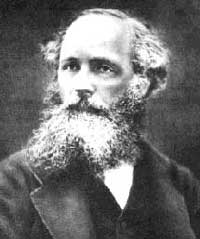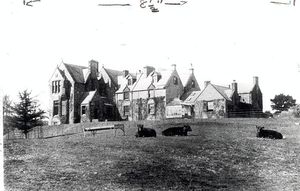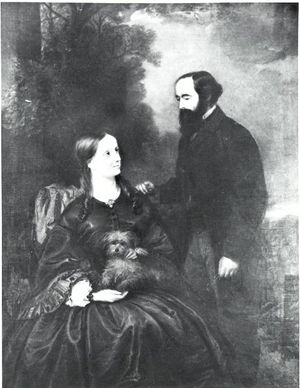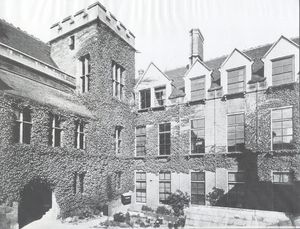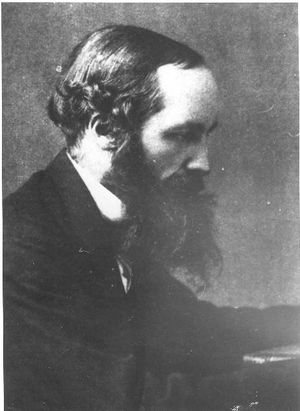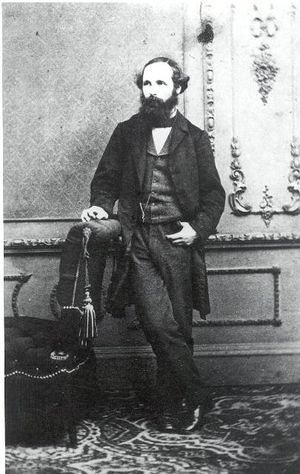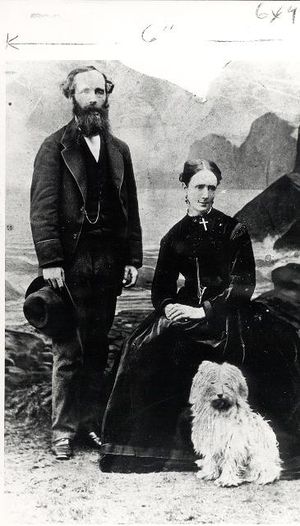James Clerk Maxwell: Difference between revisions
No edit summary |
m (Text replace - "[[Category:Scientific tools and discoveries" to "[[Category:Engineering fundamentals") |
||
| Line 56: | Line 56: | ||
Basil Mahon, The Man Who Changed Everything: The Life of James Clerk Maxwell, (Chichester, UK: John Wiley & Sons, 2003).<br> | Basil Mahon, The Man Who Changed Everything: The Life of James Clerk Maxwell, (Chichester, UK: John Wiley & Sons, 2003).<br> | ||
[[Category:People and organizations|Maxwell]] [[Category:Scientists|Maxwell]] [[Category:Fields, waves & electromagnetics|Maxwell]] [[Category:Electromagnetics|Maxwell]] [[Category:Electromagnetic fields|Maxwell]] [[Category: | [[Category:People and organizations|Maxwell]] [[Category:Scientists|Maxwell]] [[Category:Fields, waves & electromagnetics|Maxwell]] [[Category:Electromagnetics|Maxwell]] [[Category:Electromagnetic fields|Maxwell]] [[Category:Engineering fundamentals|Maxwell]] [[Category:Mathematics|Maxwell]] [[Category:News|Maxwell]] | ||
Revision as of 16:32, 22 July 2014
Biography
Born: 13 June 1831
Died: 05 November 1879
James Clerk Maxwell first introduced his mathematical conceptualization of electromagnetic phenomena 150 years ago. Presented to the Cambridge Philosophical Society in 1855, this paper was the first of three on the subject that Maxwell would pen in a 10-year span. His portrayal of electromagnetic forces as “fields” revolutionized physics. In giving a mathematical foundation to Faraday’s qualitative notion of lines-of-force, Maxwell provided the intellectual wellspring from which much of electrical engineering would flow. But let us not forget that the ascendancy of Maxwell’s concept of the electromagnetic field did not come without a long and, sometimes, bitter fight. The debate was the classic dichotomy of theory vs. practice. Electrical engineers, electricians as they were then called, saw no value in the field concept to the practical development of electrical technology. Still rooted in action-at-a-distance, these opponents saw the field concept as pure “bug-a-boo.” It would take the efforts of the “Maxwellians,” most of who were physics professors; Heinrich Hertz’s experiments; and the mounting technical difficulties arising from alternating currents, before Maxwell’s theory would gain universal acceptance.
Maxwell was one of the great scientific minds of the 19th century. In addition to his groundbreaking work in electrodynamics, Maxwell created the field of statistical mechanics, and did pioneering work in the theory of color and color perception. He has been called the Newton and the Einstein of the 19th century. His scientific accomplishments have been studied in some detail, but what do we know of the man? Although several biographies have been written on Maxwell in recent years, Lewis Campbell’s 1882 biography still remains the most compelling and detailed view of Maxwell the man. They had met as boys at the Edinburgh Academy, in Edinburgh, Scotland. Campbell went on to become a professor of Classics at the University of St. Andrews. Although their careers took them in different directions, they remained in close and constant contact. Campbell’s biography is an affectionate portrait of a close friend.
From Campbell’s writings, Maxwell emerges as man of profound simplicity, extraordinary gentleness and great humility. “[Maxwell’s] tenderness for all living things,” recalled Campbell, “was deep and instinctive; from his earliest childhood he could not hurt a fly.” Even when giving well-deserved criticism, Maxwell had a soft spot. On one occasion, he wrote a scathing review in Nature of a book written by Frederick Guthrie, a professor of physics. The book was intended to popularize science to schoolchildren. Maxwell found that the book did more harm than good and said so in the review. But Maxwell’s compassionate side realized that Guthrie was doing the best he could. Some weeks later, a humorous poem was sent to Guthrie that poked fun at Maxwell for being so heavy-handed in his public criticism of the book. The poem was subsequently published in Nature. Although never signed by Maxwell, everyone knew he was the author. Having fun at his own expense was Maxwell’s way of cheering up Guthrie.
Maxwell was noted for his sense of humor. Conversations with Maxwell could be peppered with many witty detours. Some labeled his humor eccentric. But Campbell explained that “it was [Maxwell’s] way of acknowledging the ‘grotesque view’ of everything. Like other humorists whom I have known,” wrote Campbell, “he never tired of a joke which once tickled him; only if retained in employment, it must always be tricked out with some new livery, and some fresh turn given to it.” His humor, although always appreciated by friends, was not well received by all. After one year in his appointment as chair of natural philosophy at Marischal College, in Aberdeen, Scotland, Maxwell complained to a friend, “no jokes of any kind are understood here. I have not made one for two months, and if I feel one coming I shall bite my tongue.”
The most intriguing aspect of Maxwell’s life that emerges from Campbell’s biography is the co-existence of a brilliant, radically original scientific mind with deeply held religious convictions. Maxwell’s letters reveal a man for whom religion is very important; a man who could cite the bible with great facility. From his letters, one also gets a picture of man who reflected a great deal on the nature of religious truths and their relation to scientific truths. He cared more for the metaphysical underpinnings of the Christian faith than he did for its institutional forms. Turning the current creationist argument of “complexity of design” on its head, Maxwell used the simplicity and universality of basic matter to bolster his faith in a God of creation. Matter across the entire universe is identical in its structure and behavior. In a public lecture Maxwell explained:
A molecule of hydrogen, whether in Sirius or Acturus, executes its vibrations in precisely the same time…No theory of evolution can be formed to account for the similarity of molecules…None of the processes of Nature, since the time when Nature began, have produced the slightest difference in the properties of any molecule. We are therefore unable to ascribe either the existence of the molecules or the identity of their properties to any of the causes we call natural.
God the Creator may have been easily reconciled with the physics of matter, but how did Maxwell reconcile the bible with biological evolution? Surprisingly, Campbell’s biography is remarkably silent on this matter. The contentious debate over Darwin’s work on the origins of the species had raged throughout Britain during Maxwell’s lifetime. His absence from the public record on this issue no doubt reflects his refusal to be drawn into this debate. A firm believer in “free will,” Maxwell did, however, wage a vigorous battle against the deterministic framework of scientific materialism. A more recent biographer, Martin Goldman, conjectures that Maxwell did not see Darwinism’s refutation of the literal interpretation of the bible as a challenge to religious faith. For Maxwell, the development of life on Earth was not pivotal to the deeper questions of physics and creation. One can only wonder what Maxwell’s reactions would be to the present day cosmological theories on the origins of the universe?
In revolutionizing physics, Maxwell set the course of electrical engineering for the next century. His keen mind moved back and forth easily between science and culture. He was indeed one of the great minds of the 19th century. And yet, to the end, he remained a humble man.
Maxwell is considered one of the most important physicists of the 19th century and of all time. His best-known discoveries concern the relationship between electricity and magnetism and are summarized in what has become known as Maxwell’s Equations, which have become a major underpinning of modern physics. In addition to this work Maxwell also made significant contributions in other areas. He did extensive work and research on the kinetic theory of gases, the nature of Saturn’s rings, and the perception of color. The latter interest led to Maxwell’s making what many consider to be the first color photograph in 1861.
Maxwell was born in 1831 and was raised as an only child after a sister died in infancy. Maxwell’s mother died when he was only 8 years old leaving his father to raise him on the family estate of Glenlair, in rural Scotland. Maxwell’s father hired a tutor to educate the boy, but the relationship between teacher and pupil was tense and difficult and marked by harsh treatment. When Maxwell’s father discovered the mistreatment, Maxwell was sent to live with an aunt and began to attend Edinburgh Academy.
Although Maxwell’s tutor had once described his young charge as “slow,” the facts suggest that the slow one in the duo may, in fact, have been the tutor who failed to recognize Maxwell’s brilliance. Maxwell was an intensely curious and talented student. At the age of 14 he made his first contribution to mathematics in the study of oval curves, and actually published a paper on the topic. At age 15 or 16 he was admitted to the University of Edinburgh. In 1850, he transferred to Trinity College, Cambridge University in England and four years later placed second in the difficult Tripos exam. He then received a fellowship to Cambridge, became a tutor himself for a while, and then, in 1856, became a professor at Marischal College in Aberdeen, Scotland. It was at Marischal that Maxwell rekindled an early interest in Saturn’s rings. Using mathematics, not a telescope, he theorized that the rings could not be solid, as was then widely believed. His paper on the subject garnered him the prestigious Adam’s Prize.
Unfortunately, just four years after joining Marischal College, Maxwell lost his professorship due to a reorganization of the faculty. A short time later, however, Maxwell became a professor at King’s College, London and remained there for six years. It was at King’s College that Maxwell performed his most important research. It was there, for example, that Maxwell worked out his “kinetic theory of gases,” which has to do with the motion of atoms in a gas and where he demonstrated color photography. Most importantly however, it was during the 1860s that Maxwell began formulating the equations that are the foundation of electromagnetic theory. This work is considered by many to be one of the greatest intellectual achievements of all time.
Maxwell’s Equations are not the four simple looking equations we use today. Initially Maxwell wrote a set of 20 equations, which were incomprehensible to most of his contemporaries. His ideas were so advanced that very few people understood the importance of what he had done. It wasn’t until a few others such as English physicist Oliver Heaviside took a look at the equations more than a decade later that their importance began to be recognized.
Maxwell retired to Glenlair in the mid 1860s and began writing what became the book Electricity and Magnetism (published in 1873). In 1871, rather reluctantly, he accepted an offer to return to Cambridge as their first Cavendish Professor of Physics. In that capacity he edited Henry Cavendish's papers and designed the world famous Cavendish Laboratory. In the spring of 1879 Maxwell’s health began to deteriorate. He and his wife, Katherine, returned to Glenlair. Although suffering from a painful cancer, Maxwell reportedly remained cheerful and calm until his death in November at the age of 48.
In his final days, Maxwell confided in a friend and colleague from Cambridge:
What is done by what I call myself is, I feel, done by something greater than myself…I have been thinking how very gently I have always been dealt with. I never had a violent shove in all my life. The only desire which I can have is like David to serve my own generation by the will of God, and then fall asleep.
Further Reading
Lewis Campbell, The Life of James Clerk Maxwell, (London, MacMillamn & Co., 1882).
Martin Goldman, The Demon in the Aether: the Story of James Clerk Maxwell, (Edinburgh: Paul Harris Publishing, 1983).
Basil Mahon, The Man Who Changed Everything: The Life of James Clerk Maxwell, (Chichester, UK: John Wiley & Sons, 2003).
